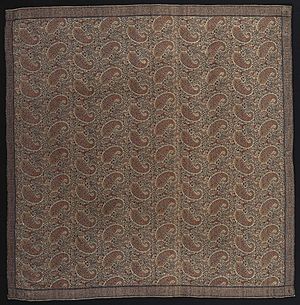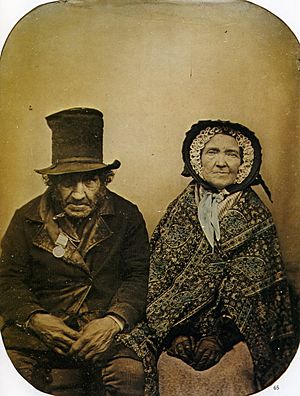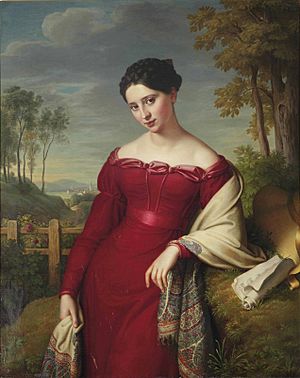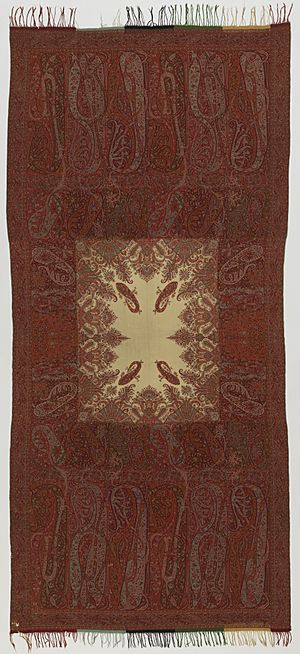Paisley shawls facts for kids
Paisley shawls were very popular fashion items for women in Europe during the late 1700s and 1800s. Many were made from soft, detailed wool. Others were printed on silk, wool, or cotton. These shawls were always very decorative. The famous teardrop shape, now called the Paisley pattern, actually came from Persia and India. It became well-known in Europe and got its name from the town of Paisley, Renfrewshire in Scotland.
A Look Back: The History of Paisley Shawls
The idea for Paisley shawls came from Kashmir shawls. These beautiful shawls were made in Kashmir, India, starting way back in the 11th century. They became even more popular in central Asia in the 1400s and 1500s. In the 1700s, people traveling and trading, especially with the British East India Company, brought Kashmir shawls to Europe.
Around 1805, towns in Europe started making their own versions of these shawls. Paisley, Scotland, became a very important place for this. It had been a weaving town for a long time. For about 70 years, Paisley was the main place in Europe where these imitation shawls were made. By 1850, more than 7,000 weavers worked there!
Other cities like Edinburgh, Glasgow, and Norwich in the UK, and places in France also made shawls. But Paisley was special. They found new ways to make shawls faster and cheaper. This meant that by 1850, Edinburgh stopped making them because they couldn't compete. Paisley's success made the teardrop pattern famous. People started calling it the 'Paisley pattern' instead of the 'pine pattern'.
Between 1841 and 1843, the shawl business had a tough time. To help, Queen Victoria bought 17 Paisley-made shawls in 1842. She often helped struggling British industries. For example, she wore Honiton lace on her wedding dress in 1840 to support that craft.
The popularity of shawls started to fade in the 1870s. One reason was that they became cheaper and easier to find. Another big reason was a change in women's fashion. Dresses changed from wide crinoline skirts to dresses with a bustle at the back. A bustle was meant to be seen, and a shawl would cover it up. Also, a shawl didn't hang nicely over a bustle. So, shawls were replaced by other wraps like mantles, capes, and dolmans. Another reason was that the Franco-Prussian War (1870-1871) stopped fine goat-hair shawls from Kashmir from reaching Europe.
How Paisley Shawls Were Made
In 1812, weavers in Paisley came up with clever ways to improve their hand-looms. They added a part that let them use five colors of wool instead of just two! Before the 1820s, weaving was often done at home. But then the Jacquard loom was invented in 1820. This machine meant weaving moved into bigger workshops. Six to eight weavers would work together in one room.
From 1820 to 1850, individual weavers made the shawls. But as more and more people wanted shawls, the way they were made had to change. The business grew, and skilled weavers started working with managers. They also worked with other trades to make more shawls faster. For example, weavers used to create their own designs. Now, patterns were given to them. This meant weavers earned less money and had less control over their work. It changed their place in society and made them less independent.
Where to See Paisley Shawls Today
You can see a collection of Paisley shawls at the Paisley Museum and Art Galleries in Scotland. They also have original hand-looms on display. This collection is very important to Scotland's history.
Also in Paisley town centre are the Sma' Shot Cottages. These cottages are looked after by volunteers. They include an original weaver's cottage from the 1750s and a mill-worker's cottage from the early 1800s. Inside, you can see objects from that time. They show how weavers and mill-workers lived. The weaver's cottage even has two original hand-looms! The Sma' Shot Cottages also have many examples of old Paisley shawls.






